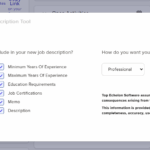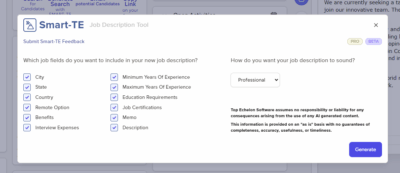Hiring and onboarding new talent is a crucial part of any business, yet it is often viewed as a time-consuming, frustrating, and drawn-out process. The recruitment process, when overloaded with unnecessary steps and inefficient practices, can not only waste time but also cause you to lose top candidates to competitors. Simplifying and accelerating the recruitment and hiring process without sacrificing quality can yield significant benefits. With businesses now relying on faster, more dynamic operations, reducing hiring timelines is not just desirable—it’s essential.
Research backs up this urgency. In Top Echelon’s 2018 State of the Industry Recruiting Report, a key statistic emerged: 22.4% of recruiters cited that one of the main reasons candidates rejected job offers was because the hiring process took too long. In a highly competitive job market, a slow hiring process means that the best candidates could easily move on to other offers.
To help streamline your hiring process, here’s an article from Top Echelon Recruiting Software to shorten your recruitment timeline, making it more efficient while still ensuring you bring in the right talent.
1. Be Selective About Candidates: The Quality-Over-Quantity Approach
A common mistake that can bog down the hiring process is casting too wide a net when seeking candidates. While it’s tempting to gather a large pool of applicants to ensure you find the best match, too many candidates can create delays as you sift through resumes and conduct interviews. Instead, aim to focus on quality over quantity.
By narrowing the applicant pool to those who meet the core qualifications for the role, you can cut down on unnecessary interviews and expedite decision-making. For example, instead of reviewing 20 candidates, narrow the focus to 8-10 exceptional ones. This more focused approach allows hiring managers to spend time on the most qualified candidates, rather than those who may not fit the role or organization as well.
A pre-screening process, whether through technology or manual effort, can help identify the most qualified individuals early on. By filtering resumes through specific qualifications or using keyword-based software, you can ensure that only the top-tier candidates are considered for interviews. In addition, leveraging referral programs within your organization can yield candidates who have already been partially vetted by current employees, adding another layer of efficiency.
2. Cut Out Unnecessary Steps: Trim the Fat in Your Hiring Process
One of the most effective ways to streamline your hiring process is by identifying and eliminating unnecessary steps. Often, companies become bogged down by outdated or redundant procedures that no longer serve a meaningful purpose.
For example, a lengthy candidate questionnaire may seem useful in theory, but if it takes days to complete and return, it could become a bottleneck. Reducing the number of questions or eliminating the form altogether could save both time and energy. Another common example is excessive interview rounds. While it’s important to thoroughly vet candidates, too many rounds of interviews can be frustrating for both the candidate and the hiring team. A more efficient approach might involve consolidating multiple interviews into one panel discussion or conducting group interviews.
A thorough review of your entire recruitment process can reveal areas where time can be saved. Map out each step and consider whether it’s truly necessary or if it could be condensed. The goal is to streamline without sacrificing the integrity of the process or the quality of the hire.
3. Utilize Technology: Automating and Enhancing Recruitment
Technology has transformed every aspect of the recruitment process, making it faster, more efficient, and more precise. Leveraging recruitment software, automation tools, and virtual platforms can drastically reduce the time it takes to find, interview, and onboard new talent.
One of the most significant advantages of modern recruitment technology is the ability to automate repetitive tasks. Applicant tracking systems (ATS) allow recruiters to manage candidate profiles, filter through resumes, schedule interviews, and even send out automated emails—all from a single platform. This consolidation of tasks not only speeds up the recruitment process but also reduces the likelihood of human error, ensuring that no important candidate is overlooked.
Video interviewing software is another time-saver, particularly in an increasingly remote work world. Virtual interviews can eliminate the need for complex scheduling arrangements, allowing recruiters to meet with candidates in different time zones or with busy schedules. Many platforms even offer features such as recorded interviews, which can be reviewed at a later time by the hiring team, allowing for greater flexibility.
Beyond interviews, technology can also assist with assessments. Tools like coding tests, behavioral assessments, and even artificial intelligence-driven evaluations can provide a clearer picture of a candidate’s abilities before they even step into an interview. This helps to filter out underqualified candidates earlier in the process, saving time for both the recruiter and the candidate.
4. Pre-Check References: Validate Candidates Early
Validating references is an essential step in the hiring process, but it’s often left until the very end, delaying final decisions and potentially causing candidates to accept offers elsewhere in the meantime. Rather than waiting until the offer stage to verify a candidate’s credentials, why not start checking references earlier in the process?
By initiating reference checks after the first or second interview, you can ensure that by the time the final decision is made, the candidate’s background is fully vetted. This proactive step eliminates last-minute delays and ensures that the hiring team can proceed with confidence once an offer is extended.
There are now automated reference checking platforms that allow for quicker and more efficient validation of a candidate’s references. These platforms streamline the process by allowing references to submit their feedback via online forms, which can then be compiled and reviewed by the hiring team. This reduces the back-and-forth of traditional phone-based reference checks, speeding up the process considerably.
5. Communicate Effectively and Efficiently: Clear and Consistent Communication
Effective communication is at the heart of a successful and speedy hiring process. It’s critical to keep all parties—candidates, recruiters, and hiring managers—informed and aligned throughout each step. Delays in communication can lead to candidates losing interest or accepting other offers, as well as internal misunderstandings that can prolong decision-making.
From the moment a candidate submits their application to the final offer, keeping the lines of communication open ensures that the process moves along smoothly. Candidates should be regularly updated on their status, and hiring managers should be kept informed of any changes or developments. Setting clear timelines for communication—for example, promising to get back to a candidate within a week of their interview—can help manage expectations and prevent frustration.
In addition, consider using multiple communication channels. While email is often the default method for professional correspondence, text messaging can be a faster way to reach candidates, particularly for scheduling updates or confirmations. For more detailed discussions, phone calls or video meetings may be more appropriate. The key is to use the right medium for the message and to ensure that communication is clear, timely, and professional.
6. Fast-Track Decision Making: Streamline Internal Approval Processes
One of the most common causes of hiring delays is the internal decision-making process. Even after interviews have been conducted and references have been checked, the final decision on whether to extend an offer can get stuck in approval limbo. A common scenario is when different stakeholders in the hiring process—such as department heads or executives—are unavailable to sign off on the final decision.
To prevent this, establish a clear and efficient decision-making process. Ensure that all necessary stakeholders are involved from the beginning of the hiring process so that they are prepared to make timely decisions when needed. Consider setting deadlines for decisions, such as requiring feedback within 48 hours of a final interview.
Implementing structured decision-making frameworks, such as scorecards or rubrics, can also help expedite the process. When hiring managers have clear criteria for evaluating candidates, they can make quicker, more confident decisions. Moreover, using collaborative platforms where all decision-makers can input their evaluations in real-time helps keep the process moving forward without unnecessary delays.
7. Prioritize Onboarding: Start the Process Before Day One
The hiring process doesn’t end with an accepted offer. Onboarding is a crucial phase that can either set a new employee up for success or leave them feeling overwhelmed and disconnected. Starting the onboarding process before the candidate’s first day can help integrate them into the team more smoothly and reduce the learning curve.
Consider sending welcome materials, company handbooks, and training schedules ahead of time so that new hires can familiarize themselves with the company before they even step through the door. Automated onboarding platforms can also facilitate the completion of paperwork, setting up accounts, and scheduling orientation meetings, allowing new employees to hit the ground running on day one.
An efficient onboarding process ensures that new hires feel supported and prepared, reducing turnover during the critical first few months of employment. A positive onboarding experience also reflects well on your organization, making it more attractive to future candidates.
Conclusion: A Faster, More Effective Hiring Process
In today’s fast-paced business environment, a slow and cumbersome hiring process is no longer acceptable. By focusing on quality candidates, eliminating unnecessary steps, utilizing technology, pre-checking references, and communicating effectively, you can significantly reduce the time it takes to bring new talent on board. The key is to streamline without sacrificing the thoroughness or integrity of your hiring decisions.
By refining your recruitment process, you not only reduce time-to-hire but also improve the candidate experience, making your company more attractive to top talent. As competition for skilled employees increases, an efficient hiring process is a critical factor in securing the best candidates and positioning your organization for future success.








